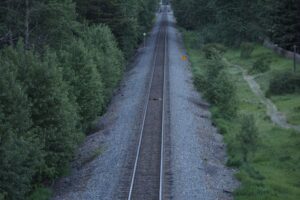
Open this photo in gallery:
No one knows how long the beloved, massive cedar stump has been anchoring the beach in Kitsilano. Experts estimate it was 800 years old when felled and weighed as much as a jumbo jet.Isabella Falsetti/The Globe and Mail
To some, the massive cedar stump at Kits Beach is a beloved icon, a playground, a perfect perch to gaze at the timbered slopes of the North Shore and the cobalt ocean beyond.
To city staff, who have slated it for removal, it is a nuisance and a safety risk – it needs to go.
Earlier this month, they began sawing the gnarled hunk of driftwood into pieces, but they had to stop the work after locals began expressing their outrage.
Experts estimate the elephantine trunk was 800 years old when felled and weighed as much as a jumbo jet. No one knows how long it has been anchoring the beach in Kitsilano. The neighbourhood, once a hippie enclave, is now Vancouver’s spandex and Gore-Tex capital, an urban oasis known for its wide, sandy beaches and leafy streets.
“It’s been there my whole life,” said former Vancouver city councillor Colleen Hardwick, whose family has lived in Kitsilano since the early 1900s, when her parents set up a general store supplying oil and coal to campers on the sandy shoreline.
“My mom told me she played on it as a kid. My own grandkids are playing on it today.”
It’s not just the age or the alluring enormousness of the thing, Ms. Hardwick said. The stump is also a reminder of a time on the West Coast when Big Timber was king and Vancouver – a city carved out of the rainforest – was a sleepy logging town cut off from the rest of Canada by the Rocky Mountains.
“It’s so important to have symbols of our past to remind us of what once was.”
But the city “just saw it as garbage – they didn’t appreciate the value of it.”
Open this photo in gallery:
Earlier this month, city staff began sawing the gnarled hunk of driftwood into pieces, but they had to stop the work after locals began expressing their outrage.Isabella Falsetti/The Globe and Mail
Parks Board staff say the landmark came to their attention earlier this summer during a routine examination of the retaining wall at the foot of the stairs from Trafalgar Street.
“Large logs can act as battering rams against shoreline structures like seawalls, pathways, and stairs,” Amit Gandha, the director of parks at the Vancouver Board of Parks and Recreation, told The Globe and Mail in a written statement. The log, he said, is being removed to protect such infrastructure.
“We’re aware that some members of the community are sorry to see the log go, however there are numerous safety and engineering considerations which necessitate its removal.”
“Crews are working to determine the best method for removing the log material as it poses a risk to infrastructure, particularly as we move into king tide season later in the year.”
Park Board Commissioner Tom Digby said he and other commissioners tried to intervene when they learned of the log’s fate, but it was too late. Nor was it within their authority, as decisions regarding public safety are made by parks staff, not elected officials.
To Mr. Digby, the log “was an iconic, beautiful, mysterious reminder of the power of nature. A trusted confidant. A faithful friend and keeper of secrets.”
Open this photo in gallery:
The stump is also a reminder of a time on the West Coast when Big Timber was king and Vancouver – a city carved out of the rainforest – was a sleepy logging town cut off from the rest of Canada by the Rocky Mountains.Isabella Falsetti/The Globe and Mail
For many, the issue isn’t whether the stump was a hazard, it’s how little effort was made to protect it.
“The thought that it’s gone is devastating,” said filmmaker David Fine, a longtime Kitsilano resident.
“It’s elegant, powerful, beautiful. It had a story. I have pictures of visitors from England, from America, all standing on the log at sunset. This is what we value in this city – our connection to nature.”
It’s the way the city weaves itself into lands not yet entirely tamed, Mr. Fine added. It’s the killer whales – and the odd grey – that occasionally visit city waters. The smells – salt, barnacles, fish, loam, trees. The giant boulders and driftwood that remind us we’re not really in charge of the world around us.
At the end of the day, this was a beloved structure that had been there for decades, one people admired and visited, Mr. Fine said. “They should have figured out a way to either secure it or move it.”
The city has not provided a timeline for the log’s destruction.
“Some people say: Get over it. It’s just a stupid log,” Mr. Fine said.
“But I think that we have the bandwidth to be concerned about really big important things – like the threat to Canada from the U.S. or wars being fought overseas – but also these little, tiny things in our community that are really important to our well-being.”
Open this photo in gallery:
Park Board Commissioner Tom Digby said he and other commissioners tried to intervene when they learned of the log’s fate, but it was too late.Isabella Falsetti/The Globe and Mail





